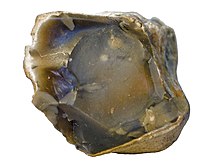
Back Vuursteen AF Pedrenya AN चकमक ANP صوان (حجر) Arabic Xil AST Çaxmaqdaşı AZ چاخماق AZB Саҡматаш BA Tėtnagos BAT-SMG Крэмень BE



Flint, or flintstone, is a kind of sedimentary rock, made of silica.
Bands of flint are found embedded in chalk and other kinds of soft limestone.
When the chalk is eroded, the hard flint nodules survive as pebbles on a shingle beach. It may happen that the pebbles later get cemented into another rock, such as a puddingstone. In this way, they make up a sedimentary rock for the second time.